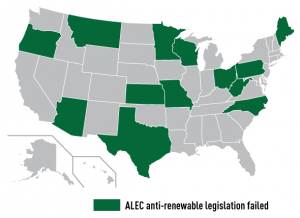Renewable Energy to Thrive in 2014, Despite ALEC’s Aggressive Tactics
 Now that 2013 is behind us, it’s important to reflect on the progress of renewable energy last year and identify obstacles that may arise in 2014.
Now that 2013 is behind us, it’s important to reflect on the progress of renewable energy last year and identify obstacles that may arise in 2014.
Over the last year, we kept a close eye on multiple clean energy attacks around the country, specifically on the Renewable Portfolio Standards (RPS) in the various states. As we have highlighted before, the “man behind the curtain” in these attacks is none other than the infamous American Legislative Exchange Council (ALEC), a front group and model bill factory for many corporate interests including oil, gas and coal.
The good news is that from Ohio to Kansas, EDF and other organizations have been successful in preventing ALEC’s aggressive tactics to hamper clean energy. To date, ALEC has failed to repeal clean energy standards in any state, despite its “Electricity Freedom Act” propaganda and promise that 2013 would be “the most active year ever” for efforts to repeal renewable energy mandates. Active? Yes. Effective? No.
A Critical Standoff in Ohio
One of the priority targets in ALEC’s 2013 agenda was to repeal Ohio’s clean energy standards adopted in 2008. The group came close to defeating the state’s widely-supported RPS standards with the introduction of Senate Bill 58, but was ultimately unsuccessful by the year’s end. This bill’s litany of bad policy includes eliminating renewable power requirements for utilities and capping energy efficiency spending.
Fortunately, EDF’s own Cheryl Roberto, former Ohio PUC Commissioner and EDF’s Associate Vice President of Clean Energy, testified against this bill and it was subsequently stalled in committee as the year drew to a close. However, it is expected to be up for a vote again sometime in January.
It’s hard to understand why ALEC would target their efforts against renewables in a state where 80 percent of Ohio voters support legally requiring the use of clean energy. And yet the organization has decided to continue its attacks in 2014, this time waging a war on homeowners.
ALEC Goes After Homeowners

ALEC is now labeling residential utility customers who produce and distribute their own energy from solar as “freeriders” who should be “paying to distribute the surplus electricity” back to the grid. On most utility bills, customers do not see itemized costs associated with transmission and distribution, meaning that once electricity is on the wires, utilities are blind, so to speak, as to who is providing and consuming the power. However, new valuation methods to address these issues are still evolving, like decoupling (which encourages energy conservation by disassociating utility profits from the sale of energy), net metering (which makes small-scale renewable energy, like rooftop solar, more affordable by crediting these “distributed generation” owners for the excess energy they produce) and the valuation of solar (which recognizes solar energy’s multiple added benefits). For ALEC to pin the costs of supplying excess power solely on the solar owner at this juncture is hasty.
Homeowners who generate their own electricity provide a service to themselves, the grid and the utility. These homeowners are reducing the demand for, and costs associated with, the delivery of that power by creating their own and acting as a backup source for power in the event the utility needs to draw on their excess supply. Apparently, ALEC doesn’t believe that these services provide value and that homeowners who invest in solar are merely “mooching” off the system.
We saw this logic play out in 2013 when Arizona Public Service, the state’s largest utility company, requested to raise its monthly charge for rooftop solar owners by an average of $50 per month. Solar owners were able to get a reprieve (for now) with regulators approving an average charge of roughly $5 per month.
In Texas, State Representative Linda Harper-Brown (R-Irving) requested a Texas Attorney General’s opinion to nullify House Bill (HB) 362, which passed during the 82nd legislative session. This bill prevents Homeowners Associations (HOA), with certain exceptions, from preventing individuals from installing rooftop solar panels on their homes. Brown feels that HOAs should have the control to stop individuals from generating their own electricity and being self-reliant.

This is another case where ALEC and the likes of Tea Partiers Ted Cruz and Paul Ryan (who both spoke at ALEC’s policy summit a few weeks ago) show their true colors by acting in the best interests of corporations, rather than their constituents. Passing laws that go after homeowners who produce their own power is in direct contradiction of the proclaimed ideologies in ALEC’s Electricity Freedom Act – but in this instance, it’s conveniently ignored.
Renewables Expected to Prevail in 2014
Luckily, Americans see through these schemes. As Texas A&M reports, 59 percent of Americans support increased funding for research and development of renewable energy sources and 60 percent support tax cuts for companies to develop renewable energy technologies. This is good news, especially considering renewable energy accounted for 100 percent of new power added to the U.S. grid in November 2013.
Despite ALEC’s misguided strategy, the wind is literally at the back of those pushing the U.S. energy revolution towards a cleaner and more sustainable future – one with cleaner air and more jobs, like in Texas, the leader in clean energy jobs. EDF is geared up to defend clean energy again in 2014 with the support of many Americans from both parties. ALEC is on the wrong side of history; maybe their New Year’s resolution will be to realize it.










